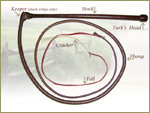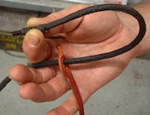

|
Caring for your Whip Your whip doesn't require a great deal more than basic common sense procedures to help it last a lifetime.
DO NOT USE ANY OIL BASED PRODUCT, INCLUDING NEATS FOOT OR MINK OIL.When your whip first arrives, give it a polish with a soft cloth. Similarly keep your whip dry and do not strike hard objects with it. Make sure you avoid striking the ground and it is probably best not to practice on concrete unless you are skilled.
|


